Comprehensive analysis of signaling lymphocyte activation molecule family as a prognostic biomarker and correlation with immune infiltration in clear cell renal cell carcinoma
- Authors:
- Na Song
- Ziwei Wang
- Pingyu Shi
- Kai Cui
- Yanwu Fan
- Liqun Zeng
- Wenyu Di
- Jinsong Li
- Wei Su
- Haijun Wang
-
Affiliations: Department of Pathology, Xinxiang Key Laboratory of Tumor Precision Medicine, The First Affiliated Hospital of Xinxiang Medical University, Weihui, Henan 453100, P.R. China, Department of Pathology, School of Basic Medical Sciences, Xinxiang Medical University, Xinxiang, Henan 453000, P.R. China - Published online on: June 3, 2024 https://doi.org/10.3892/ol.2024.14487
- Article Number: 354
-
Copyright: © Song et al. This is an open access article distributed under the terms of Creative Commons Attribution License.
This article is mentioned in:
Abstract
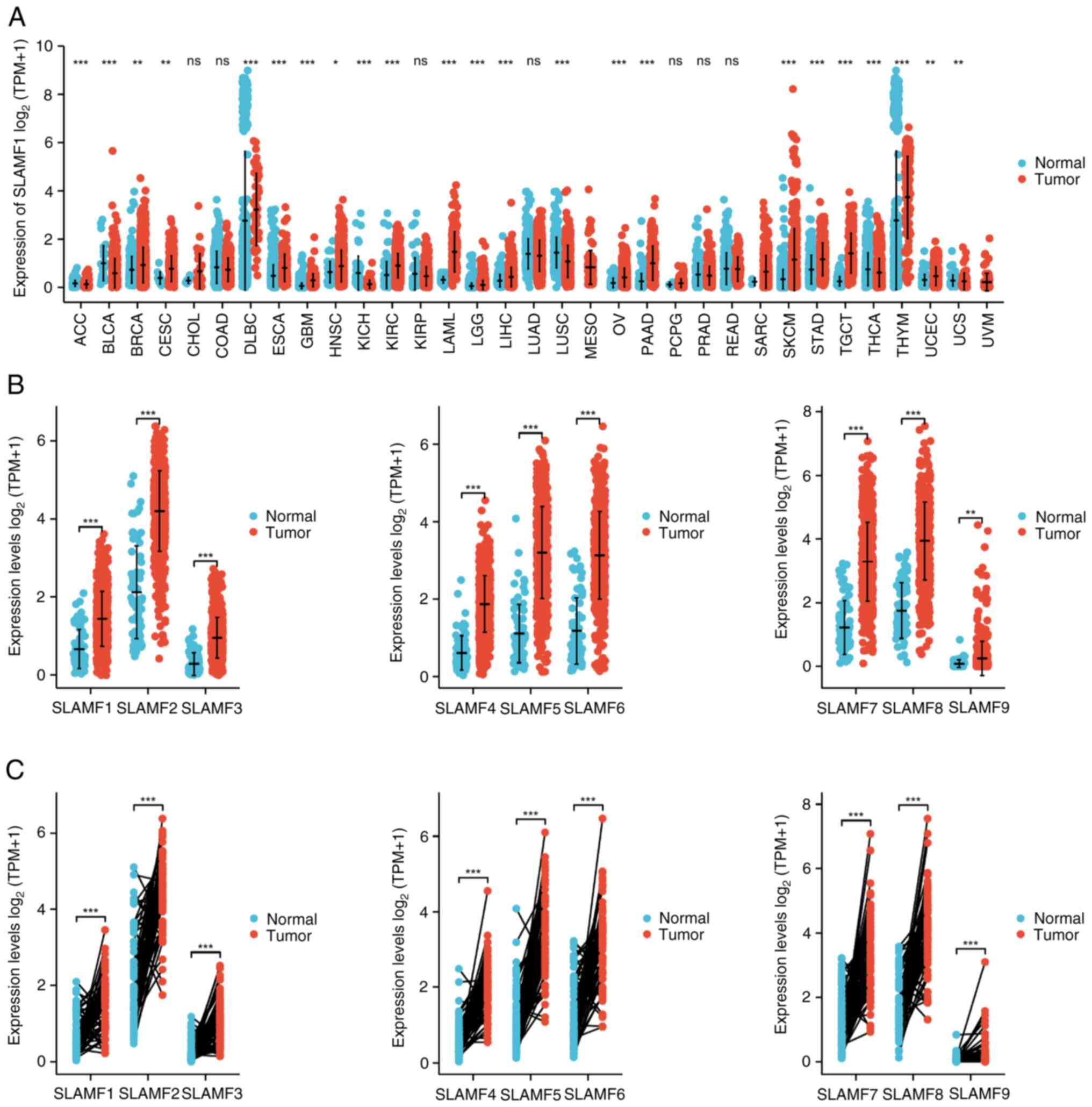 |
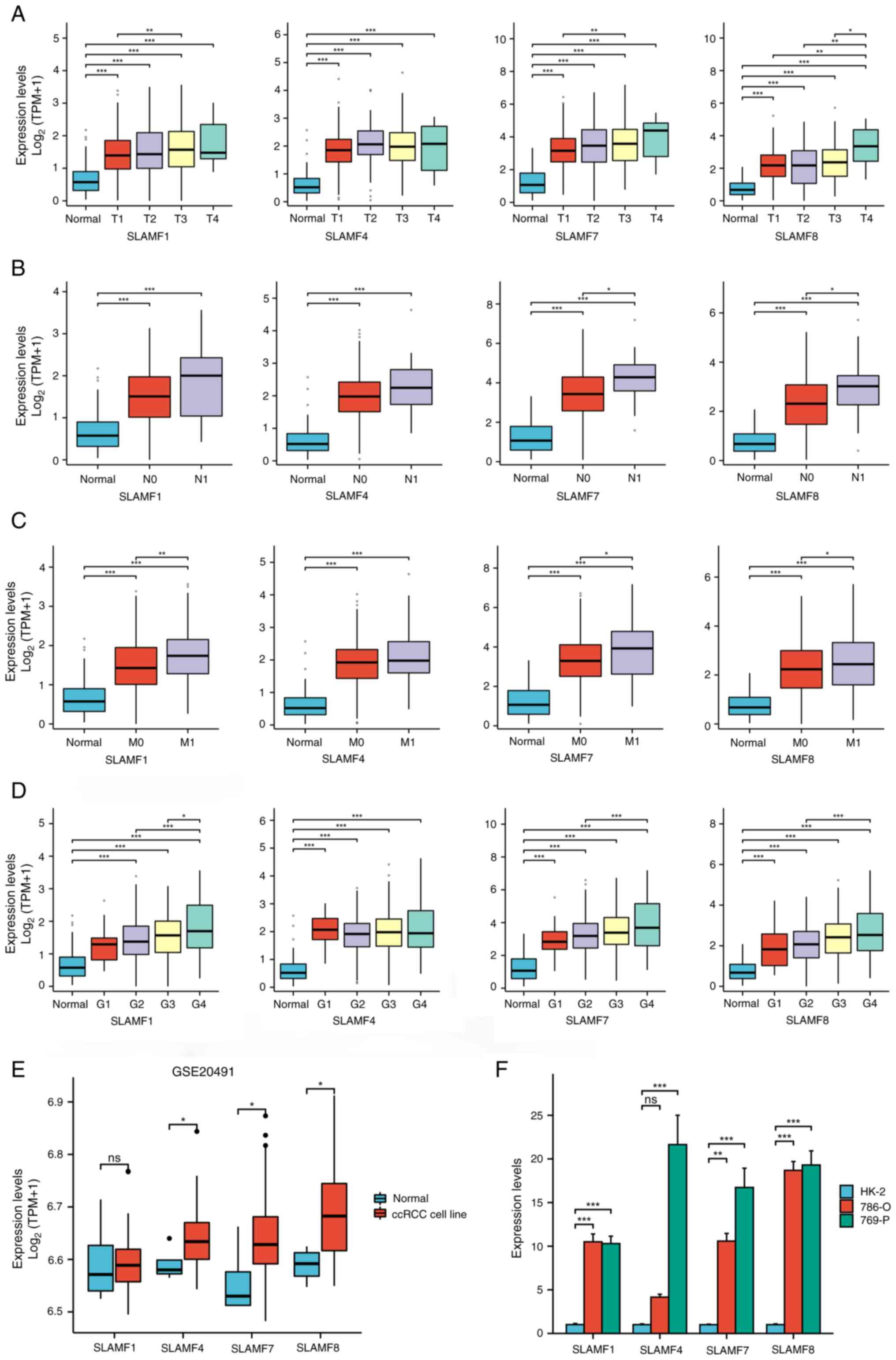 |
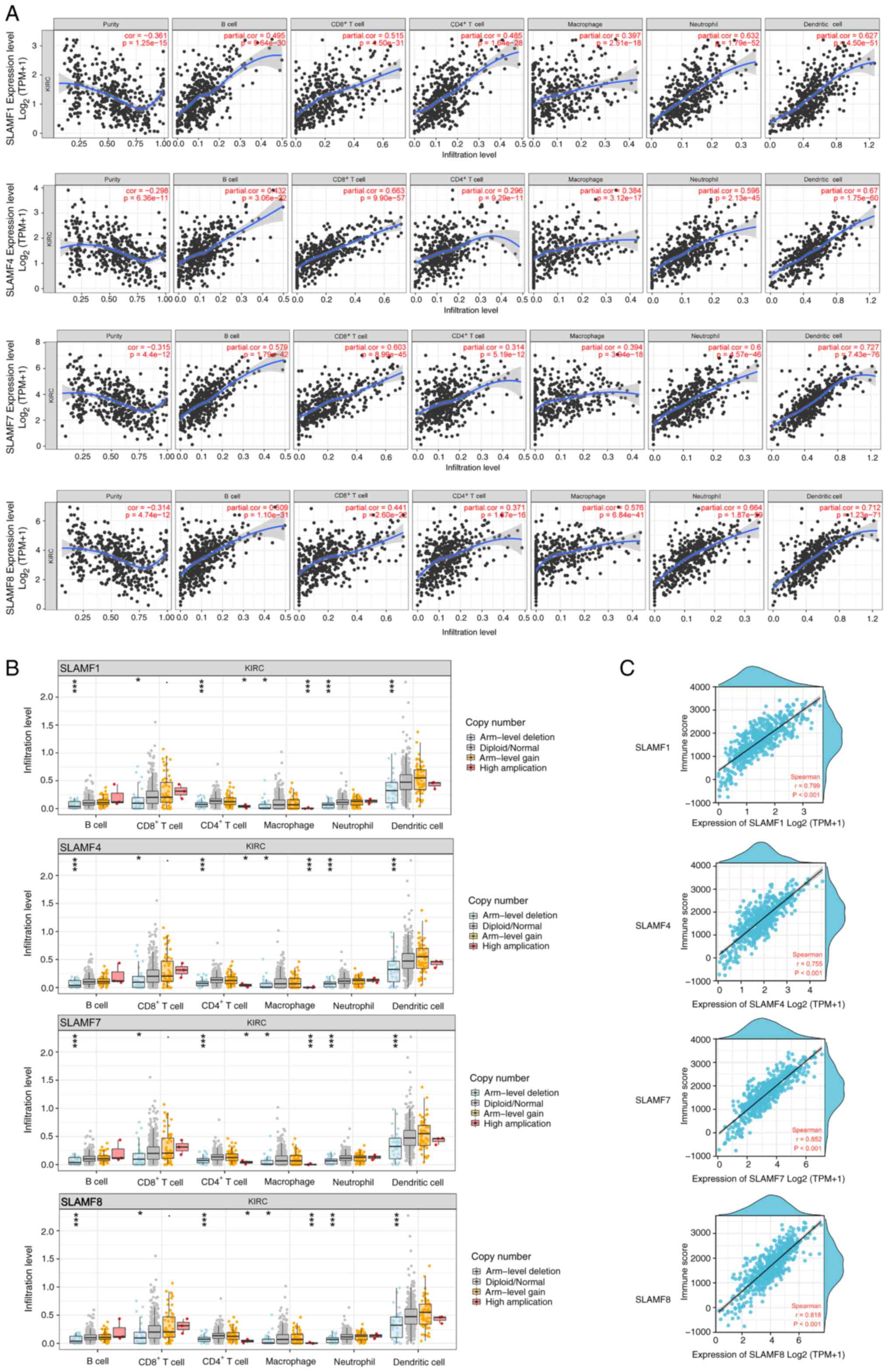 |
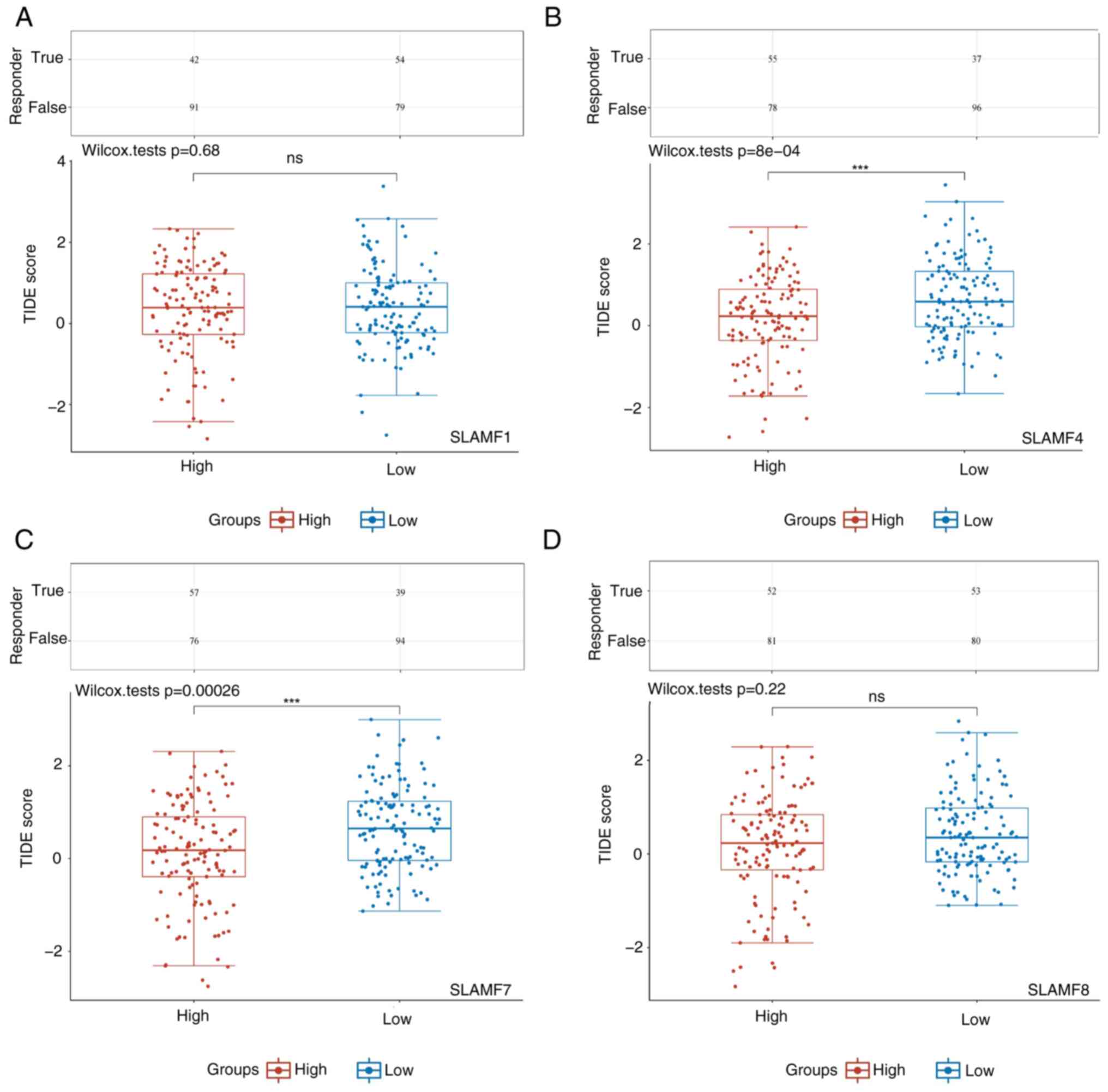 |
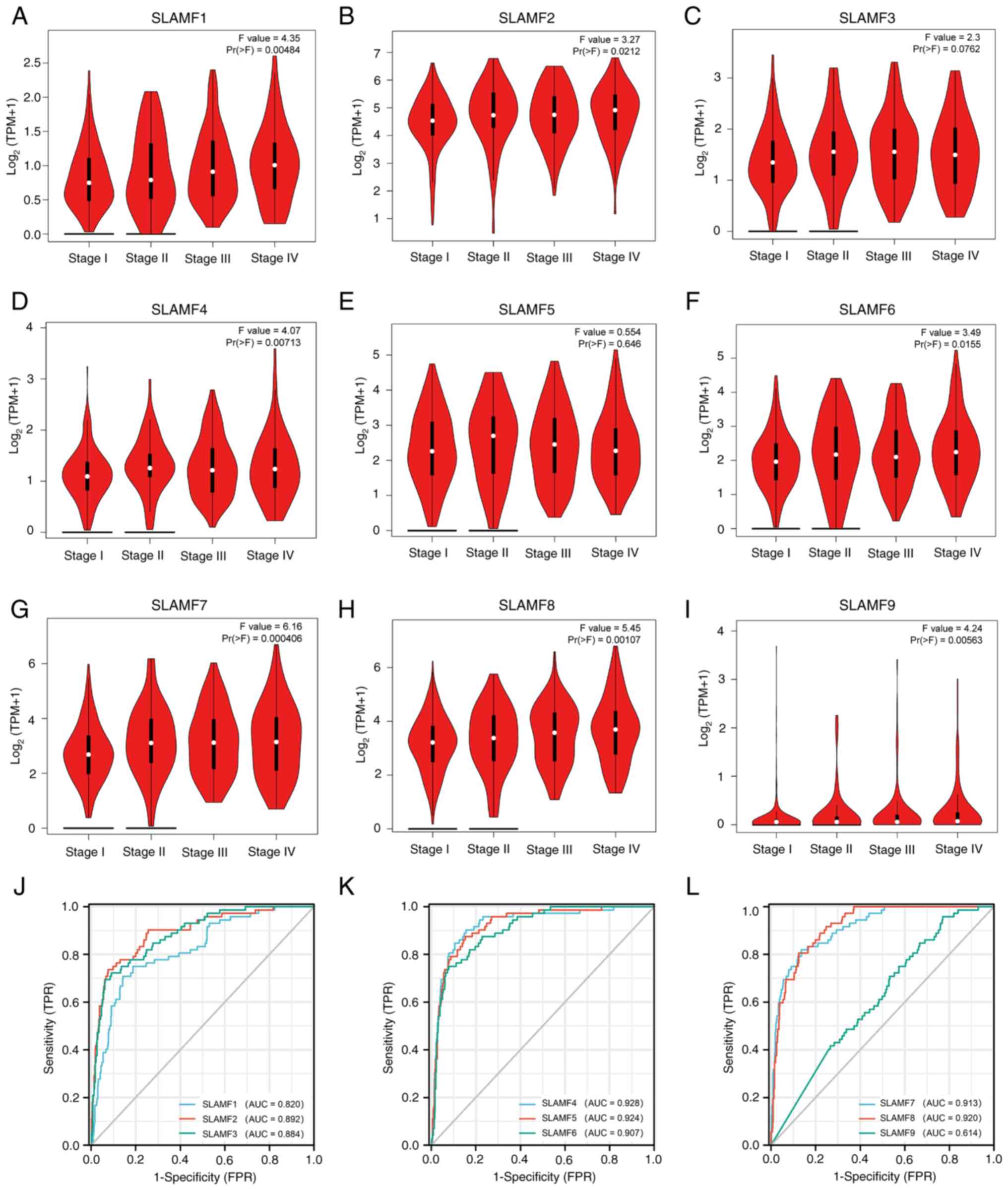 |
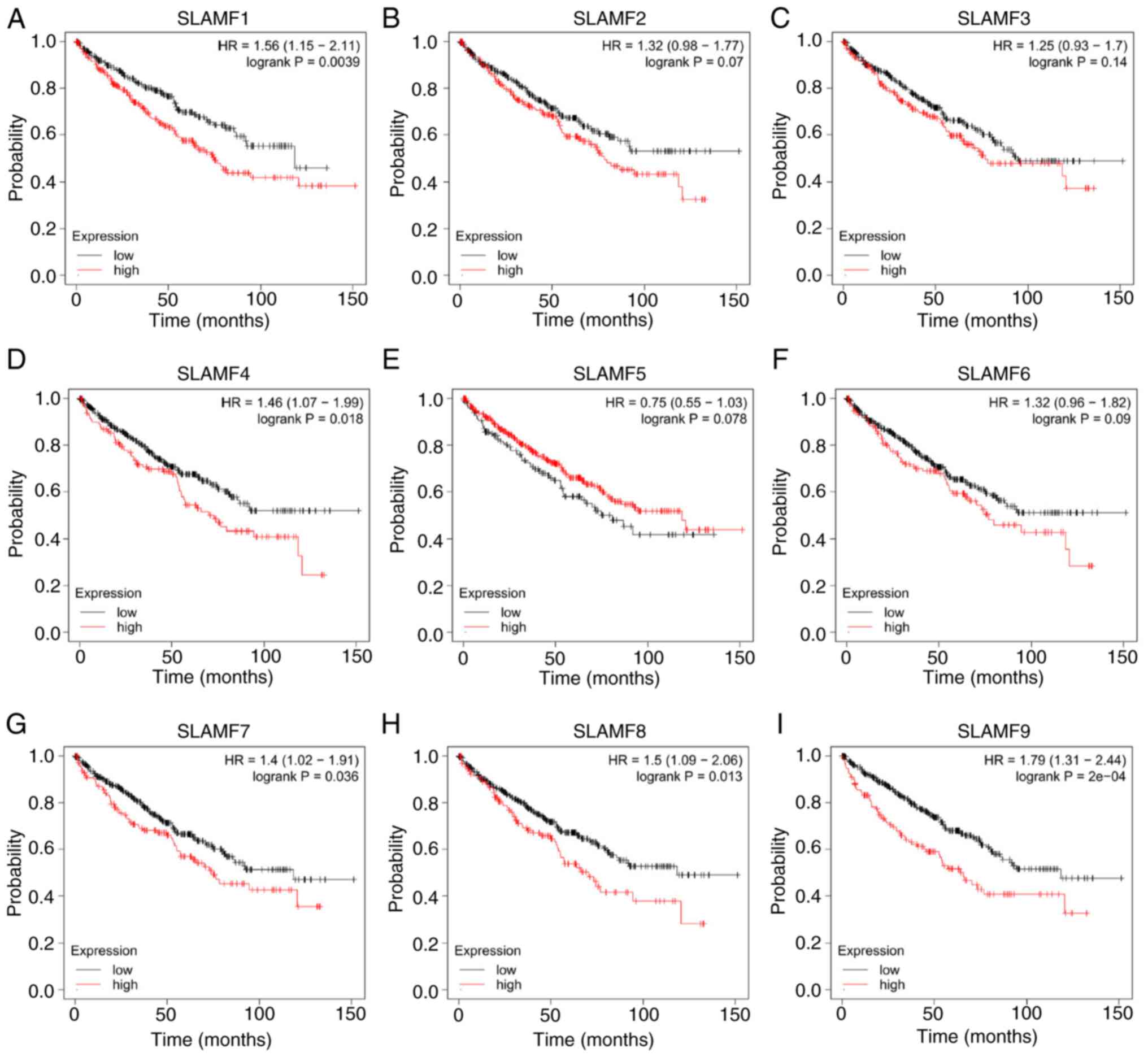 |
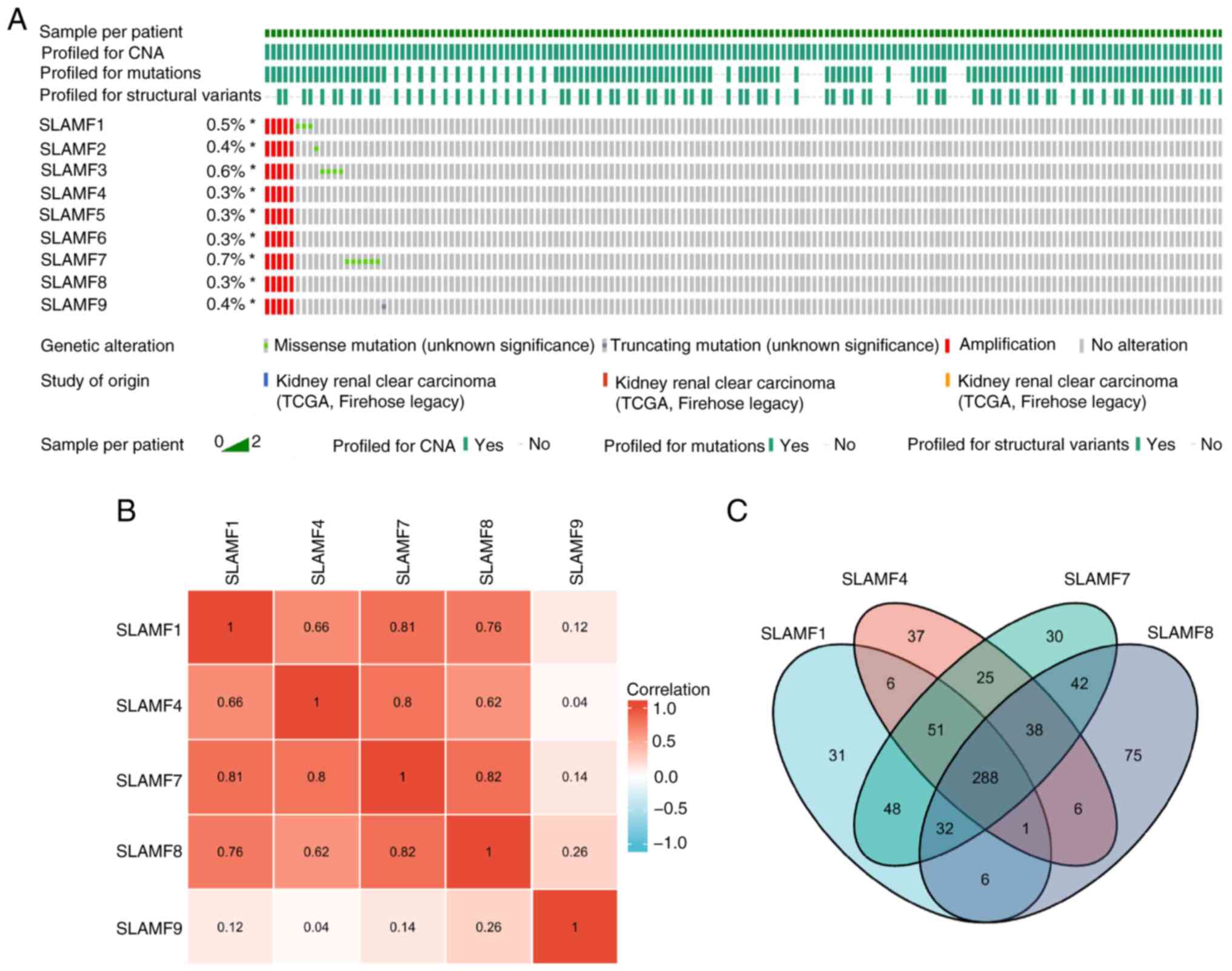 |
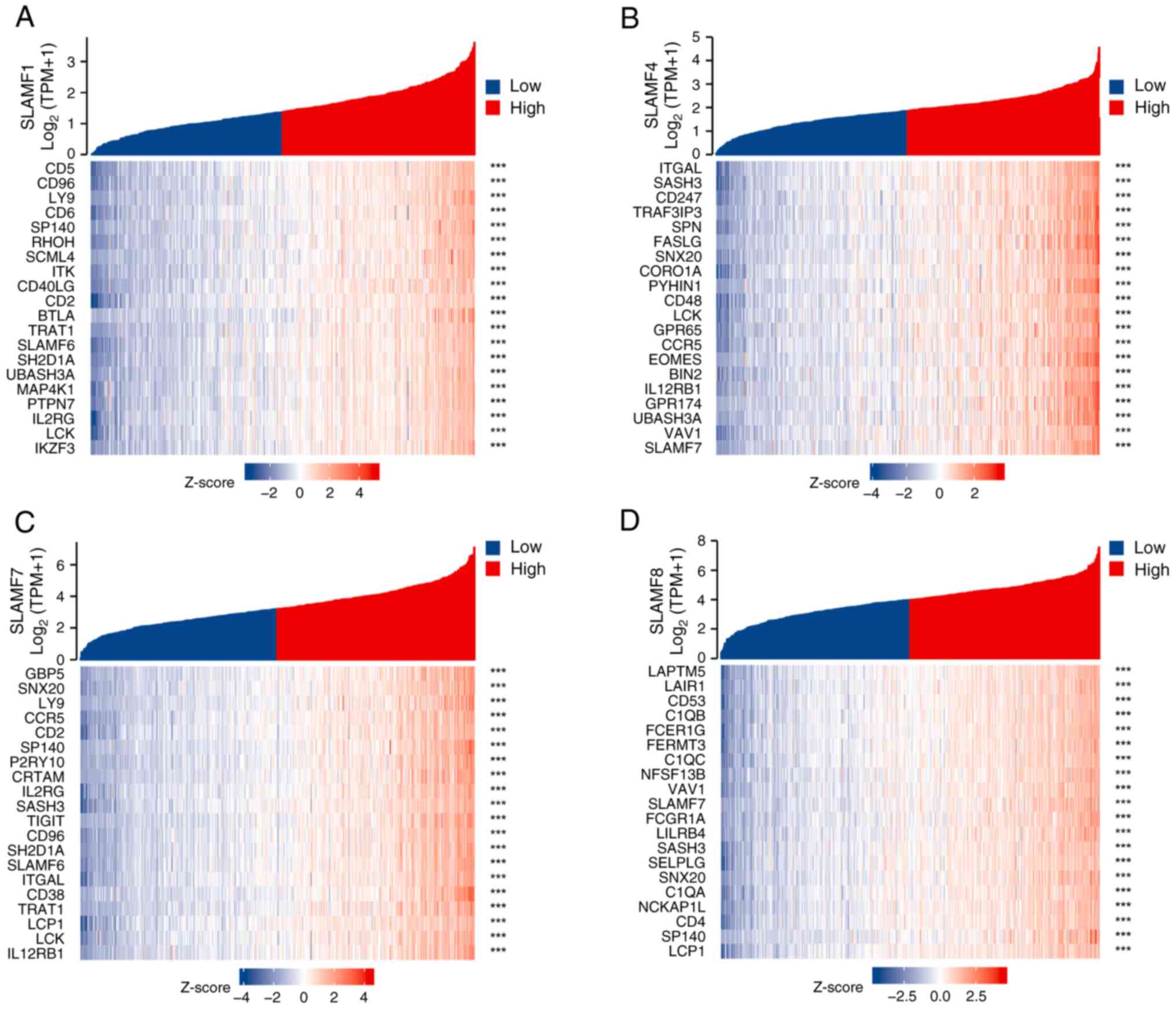 |
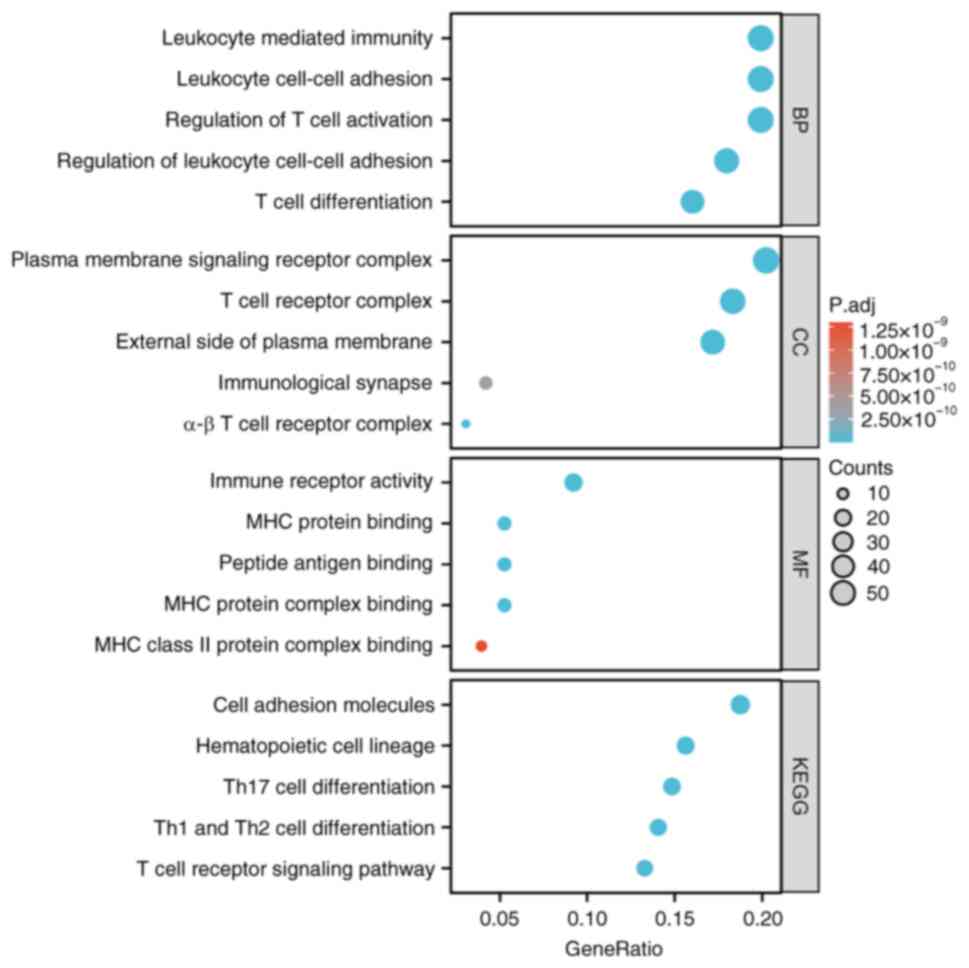 |
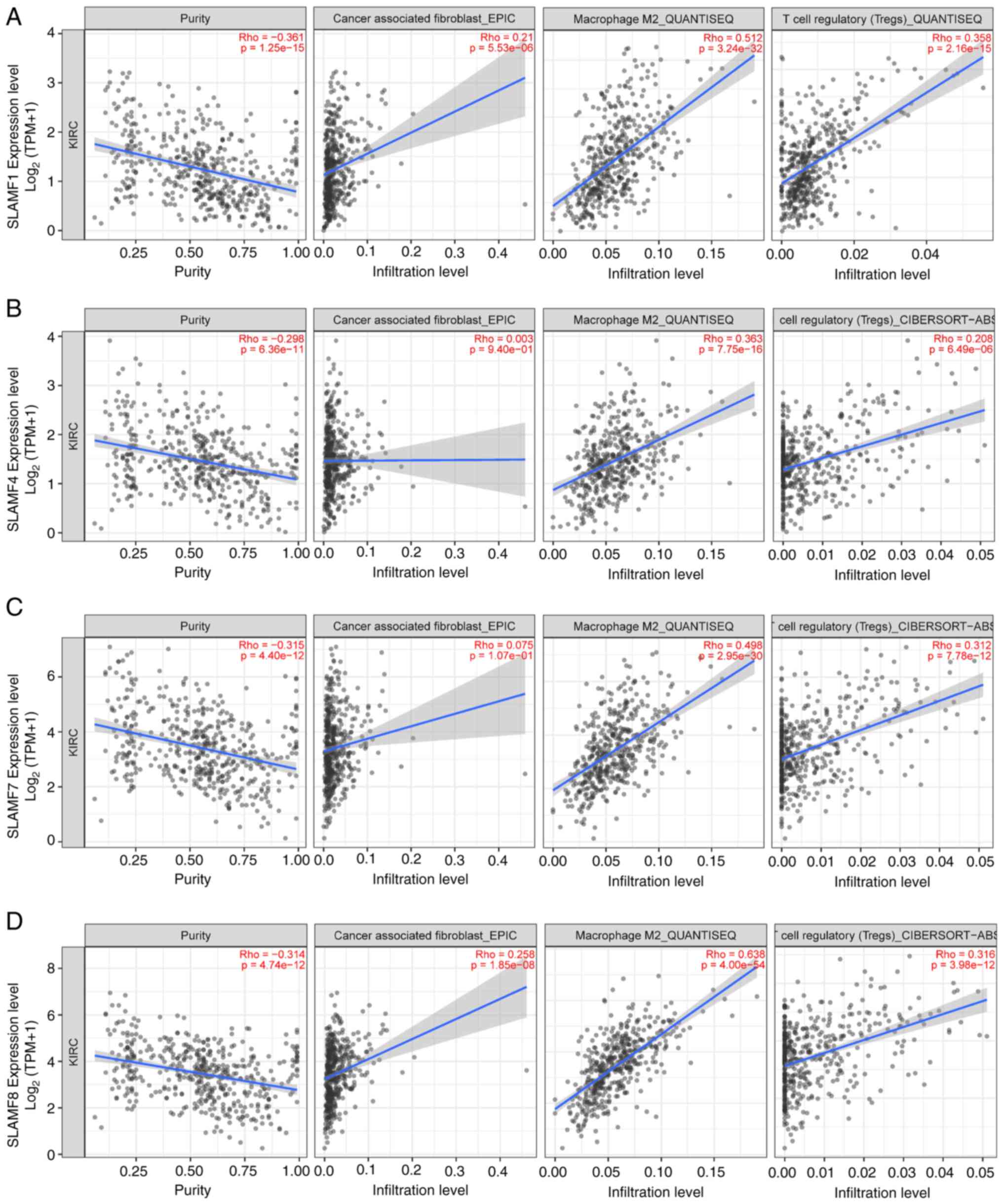 |
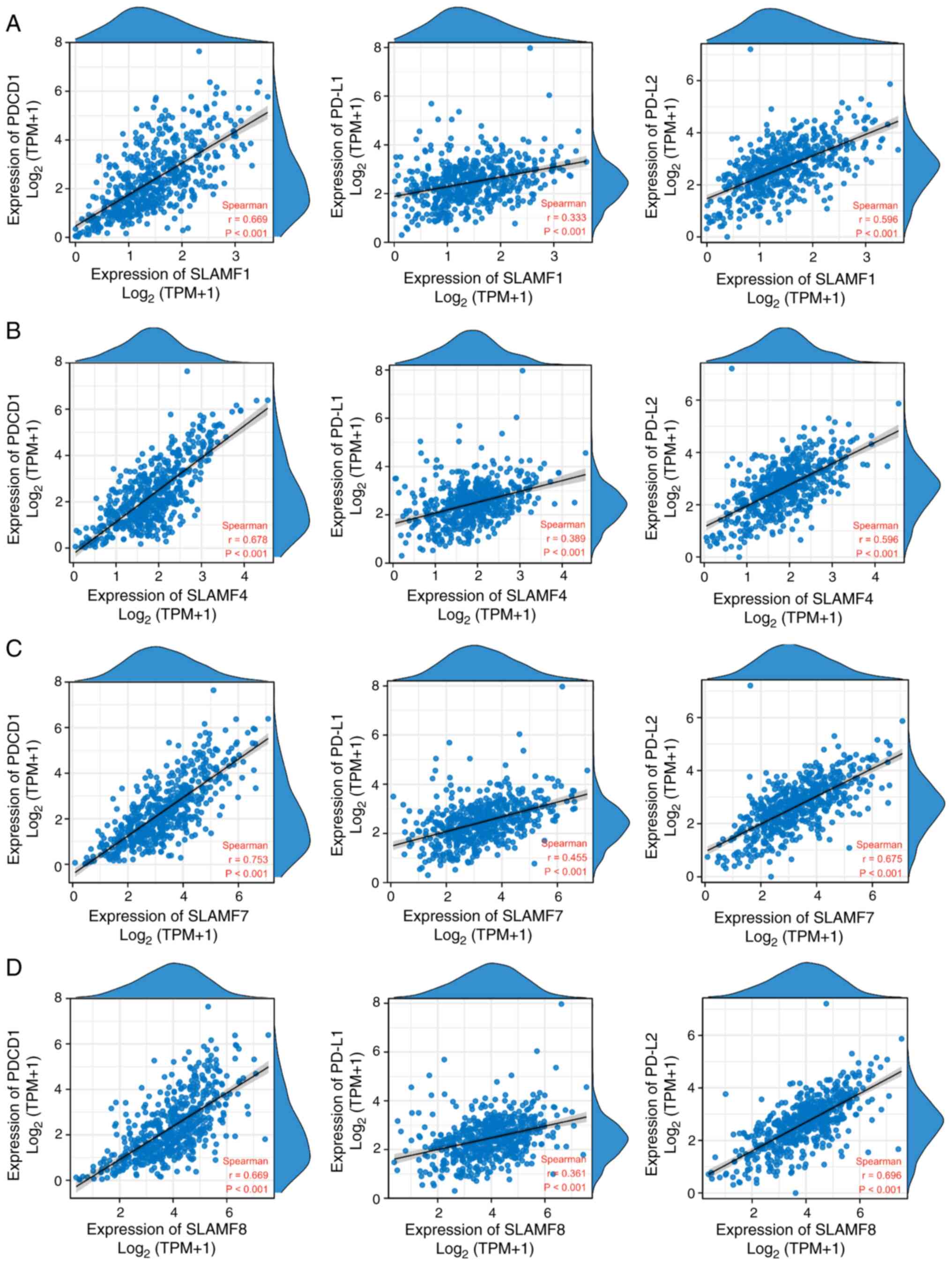 |
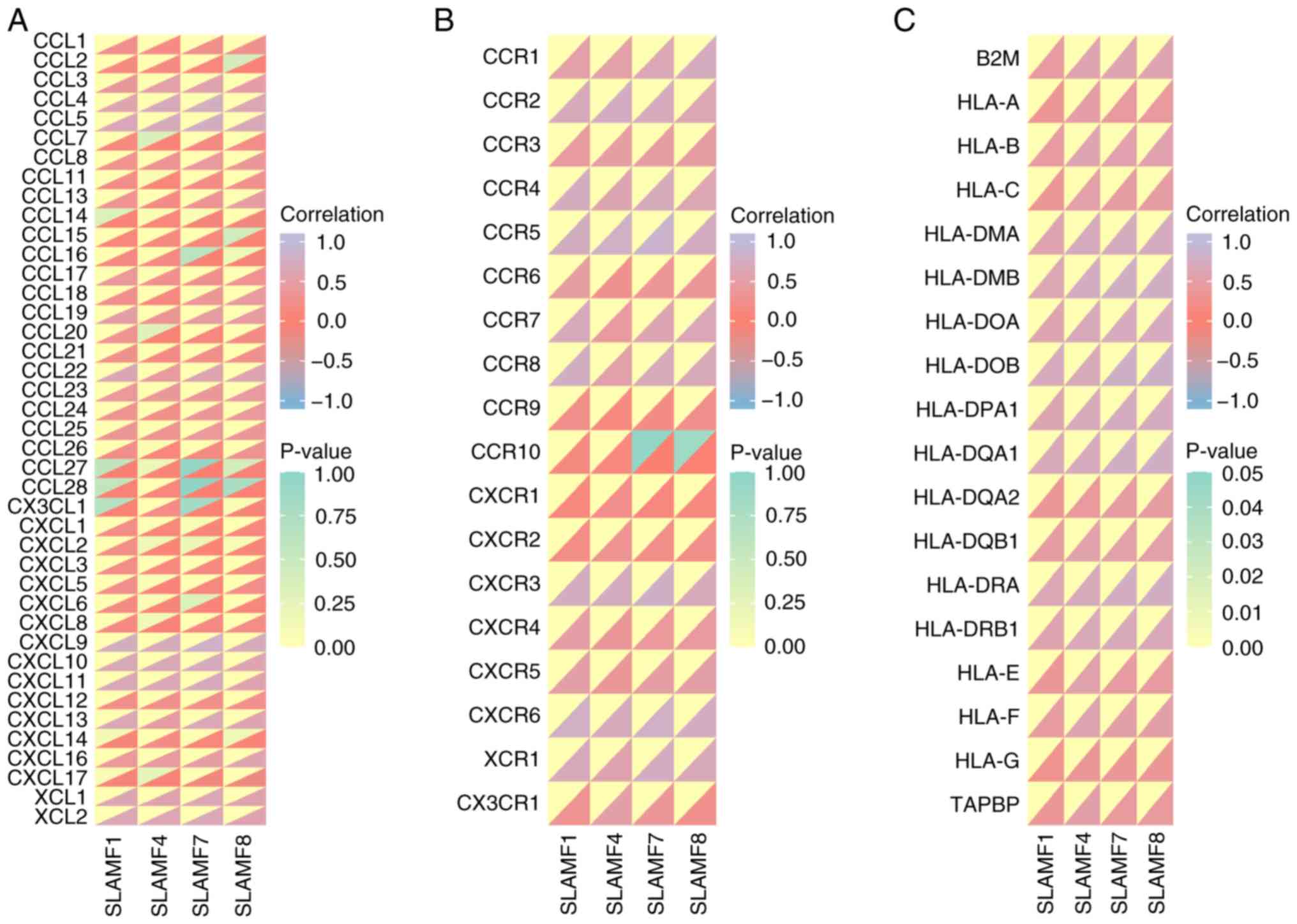 |
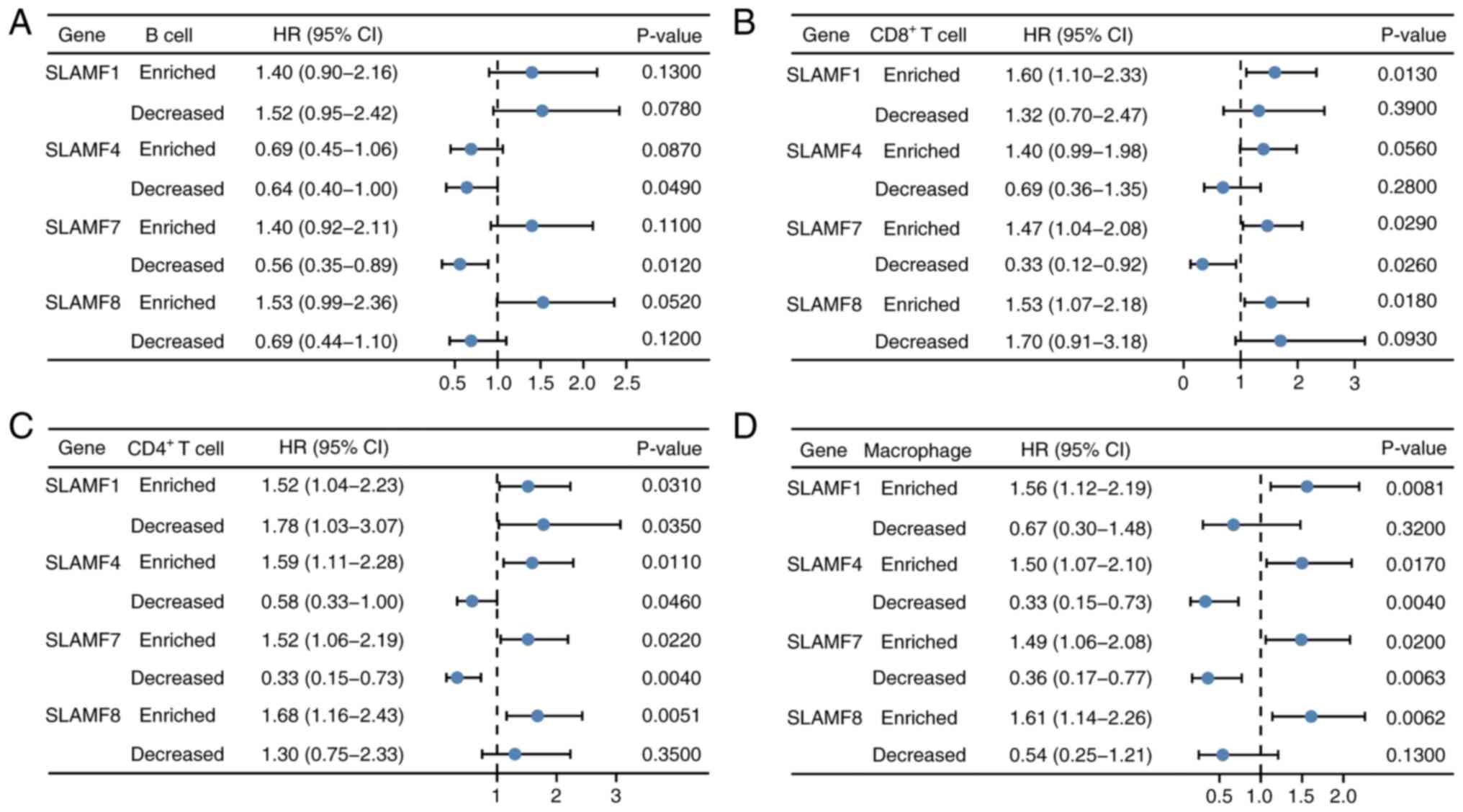 |
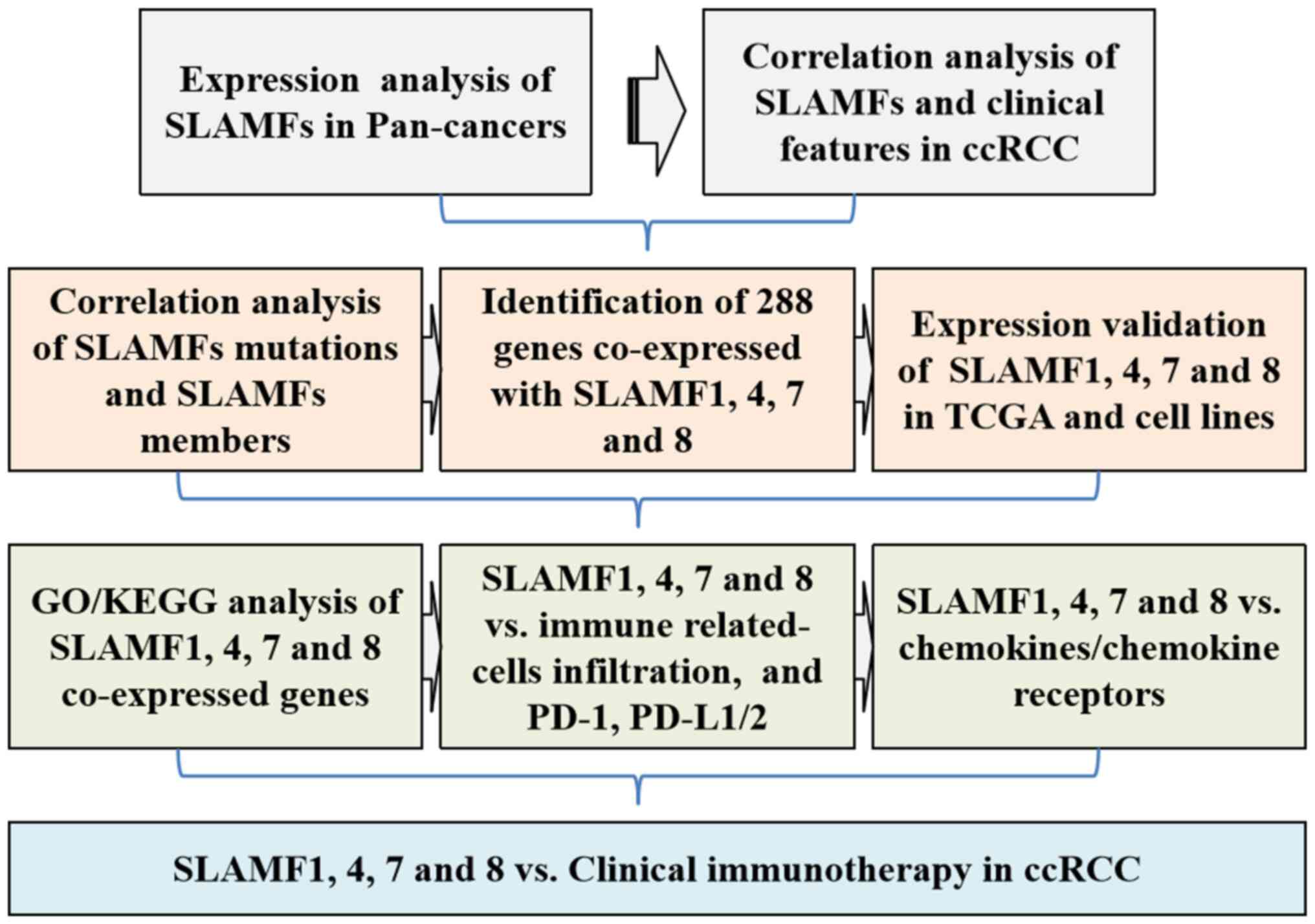 |
|
Siegel RL, Miller KD, Fuchs HE and Jemal A: Cancer statistics, 2021. CA Cancer J Clin. 71:7–33. 2021. View Article : Google Scholar : PubMed/NCBI | |
|
Moch H, Cubilla AL, Humphrey PA, Reuter VE and Ulbright TM: The 2016 WHO classification of tumours of the urinary system and male genital organs-part A: Renal, penile, and testicular tumours. Eur Urol. 70:93–105. 2016. View Article : Google Scholar : PubMed/NCBI | |
|
Marchetti A, Rosellini M, Mollica V, Rizzo A, Tassinari E, Nuvola G, Cimadamore A, Santoni M, Fiorentino M, Montironi R and Massari F: The molecular characteristics of non-clear cell renal cell carcinoma: What's the story morning glory? Int J Mol Sci. 22:62372021. View Article : Google Scholar : PubMed/NCBI | |
|
Jiang J, Han P, Qian J, Zhang S, Wang S, Cao Q and Shao P: Knockdown of ALPK2 blocks development and progression of renal cell carcinoma. Exp Cell Res. 392:1120292020. View Article : Google Scholar : PubMed/NCBI | |
|
He YH, Chen C and Shi Z: The biological roles and clinical implications of microRNAs in clear cell renal cell carcinoma. J Cell Physiol. 233:4458–4465. 2018. View Article : Google Scholar : PubMed/NCBI | |
|
Gao S, Yan L, Zhang H, Fan X, Jiao X and Shao F: Identification of a metastasis-associated gene signature of clear cell renal cell carcinoma. Front Genet. 11:6034552021. View Article : Google Scholar : PubMed/NCBI | |
|
Cochetti G, Cari L, Nocentini G, Maulà V, Suvieri C, Cagnani R, Rossi De Vermandois JA and Mearini E: Detection of urinary miRNAs for diagnosis of clear cell renal cell carcinoma. Sci Rep. 10:212902020. View Article : Google Scholar : PubMed/NCBI | |
|
Obeng RC, Arnold RS, Ogan K, Master VA, Pattaras JG, Petros JA and Osunkoya AO: Molecular characteristics and markers of advanced clear cell renal cell carcinoma: Pitfalls due to intratumoral heterogeneity and identification of genetic alterations associated with metastasis. Int J Urol. 27:790–797. 2020. View Article : Google Scholar : PubMed/NCBI | |
|
Cros J, Sbidian E, Posseme K, Letierce A, Guettier C, Benoît G and Ferlicot S: Nestin expression on tumour vessels and tumour-infiltrating macrophages define a poor prognosis subgroup of pt1 clear cell renal cell carcinoma. Virchows Arch. 469:331–337. 2016. View Article : Google Scholar : PubMed/NCBI | |
|
Janowitz T, Welsh SJ, Zaki K, Mulders P and Eisen T: Adjuvant therapy in renal cell carcinoma-past, present, and future. Semin Oncol. 40:482–491. 2013. View Article : Google Scholar : PubMed/NCBI | |
|
Motzer RJ, Jonasch E, Agarwal N, Alva A, Baine M, Beckermann K, Carlo MI, Choueiri TK, Costello BA, Derweesh IH, et al: Kidney cancer, version 3.2022, NCCN clinical practice guidelines in oncology. J Natl Compr Canc Netw. 20:71–90. 2022. View Article : Google Scholar : PubMed/NCBI | |
|
Rosellini M, Marchetti A, Mollica V, Rizzo A, Santoni M and Massari F: Prognostic and predictive biomarkers for immunotherapy in advanced renal cell carcinoma. Nat Rev Urol. 20:133–157. 2023. View Article : Google Scholar : PubMed/NCBI | |
|
Wang B, Chen D and Hua H: TBC1D3 family is a prognostic biomarker and correlates with immune infiltration in kidney renal clear cell carcinoma. Mol Ther Oncolytics. 22:528–538. 2021. View Article : Google Scholar : PubMed/NCBI | |
|
Santoni M, Rizzo A, Mollica V, Matrana MR, Rosellini M, Faloppi L, Marchetti A, Battelli N and Massari F: The impact of gender on the efficacy of immune checkpoint inhibitors in cancer patients: The MOUSEION-01 study. Crit Rev Oncol Hematol. 170:1035962022. View Article : Google Scholar : PubMed/NCBI | |
|
Rizzo A, Mollica V, Dall'Olio FG, Ricci AD, Maggio I, Marchetti A, Rosellini M, Santoni M, Ardizzoni A and Massari F: Quality of life assessment in renal cell carcinoma phase II and III clinical trials published between 2010 and 2020: A systematic review. Future Oncol. 17:2671–2681. 2021. View Article : Google Scholar : PubMed/NCBI | |
|
Mollica V, Rizzo A, Marchetti A, Tateo V, Tassinari E, Rosellini M, Massafra R, Santoni M and Massari F: The impact of ECOG performance status on efficacy of immunotherapy and immune-based combinations in cancer patients: The MOUSEION-06 study. Clin Exp Med. 23:5039–5049. 2023. View Article : Google Scholar : PubMed/NCBI | |
|
Dragovich MA and Mor A: The SLAM family receptors: Potential therapeutic targets for inflammatory and autoimmune diseases. Autoimmun Rev. 17:674–682. 2018. View Article : Google Scholar : PubMed/NCBI | |
|
Gunes M, Rosen ST, Shachar I and Gunes EG: Signaling lymphocytic activation molecule family receptors as potential immune therapeutic targets in solid tumors. Front Immunol. 15:12974732024. View Article : Google Scholar : PubMed/NCBI | |
|
Farhangnia P, Ghomi SM, Mollazadehghomi S, Nickho H, Akbarpour M and Delbandi AA: SLAM-family receptors come of age as a potential molecular target in cancer immunotherapy. Front Immunol. 14:11741382023. View Article : Google Scholar : PubMed/NCBI | |
|
Tojjari A, Giles FJ, Vilbert M, Saeed A and Cavalcante L: SLAM modification as an immune-modulatory therapeutic approach in cancer. Cancers (Basel). 15:48082023. View Article : Google Scholar : PubMed/NCBI | |
|
Su R, Jin C, Zhou L, Cao Y, Kuang M, Li L and Xiang J: Construction of a ceRNA network of hub genes affecting immune infiltration in ovarian cancer identified by WGCNA. BMC Cancer. 21:9702021. View Article : Google Scholar : PubMed/NCBI | |
|
Lewinsky H, Gunes EG, David K, Radomir L, Kramer MP, Pellegrino B, Perpinial M, Chen J, He TF, Mansour AG, et al: CD84 is a regulator of the immunosuppressive microenvironment in multiple myeloma. JCI Insight. 6:e1416832021.PubMed/NCBI | |
|
O'Connell P, Hyslop S, Blake MK, Godbehere S, Amalfitano A and Aldhamen YA: SLAMF7 Signaling reprograms t cells toward exhaustion in the tumor microenvironment. J Immunol. 206:193–205. 2021. View Article : Google Scholar : PubMed/NCBI | |
|
Agresta L, Hoebe KHN and Janssen EM: The emerging role of CD244 signaling in immune cells of the tumor microenvironment. Front Immunol. 9:28092018. View Article : Google Scholar : PubMed/NCBI | |
|
Yigit B, Wang N, Ten Hacken E, Chen SS, Bhan AK, Suarez-Fueyo A, Katsuyama E, Tsokos GC, Chiorazzi N, Wu CJ, et al: SLAMF6 as a regulator of exhausted CD8+ T cells in cancer. Cancer Immunol Res. 7:1485–1496. 2019. View Article : Google Scholar : PubMed/NCBI | |
|
GTEx Consortium: The genotype-tissue expression (GTEx) project. Nat Genet. 45:580–585. 2013. View Article : Google Scholar : PubMed/NCBI | |
|
Vivian J, Rao AA, Nothaft FA, Ketchum C, Armstrong J, Novak A, Pfeil J, Narkizian J, Deran AD, Musselman-Brown A, et al: Toil enables reproducible, open source, big biomedical data analyses. Nat Biotechnol. 35:314–316. 2017. View Article : Google Scholar : PubMed/NCBI | |
|
Tang Z, Kang B, Li C, Chen T and Zhang Z: GEPIA2: An enhanced web server for large-scale expression profiling and interactive analysis. Nucleic Acids Res. 47((W1)): W556–W560. 2019. View Article : Google Scholar : PubMed/NCBI | |
|
Chandrashekar DS, Bashel B, Balasubramanya SAH, Creighton CJ, Ponce-Rodriguez I, Chakravarthi BVSK and Varambally S: UALCAN: A portal for facilitating tumor subgroup gene expression and survival analyses. Neoplasia. 19:649–658. 2017. View Article : Google Scholar : PubMed/NCBI | |
|
Obuchowski NA and Bullen JA: Receiver operating characteristic (ROC) curves: Review of methods with applications in diagnostic medicine. Phys Med Biol. 63:07TR012018. View Article : Google Scholar : PubMed/NCBI | |
|
Lánczky A and Győrffy B: Web-based survival analysis tool tailored for medical research (KMplot): Development and implementation. J Med Internet Res. 23:e276332021. View Article : Google Scholar : PubMed/NCBI | |
|
Cerami E, Gao J, Dogrusoz U, Gross BE, Sumer SO, Aksoy BA, Jacobsen A, Byrne CJ, Heuer ML, Larsson E, et al: The cBio cancer genomics portal: an open platform for exploring multidimensional cancer genomics data. Cancer Discov. 2:401–404. 2012. View Article : Google Scholar : PubMed/NCBI | |
|
Gao J, Aksoy BA, Dogrusoz U, Dresdner G, Gross B, Sumer SO, Sun Y, Jacobsen A, Sinha R, Larsson E, et al: Integrative analysis of complex cancer genomics and clinical profiles using the cBioPortal. Sci Signal. 6:pl12013. View Article : Google Scholar : PubMed/NCBI | |
|
Subramanian A, Tamayo P, Mootha VK, Mukherjee S, Ebert BL, Gillette MA, Paulovich A, Pomeroy SL, Golub TR, Lander ES and Mesirov JP: Gene set enrichment analysis: A knowledge-based approach for interpreting genome-wide expression profiles. Proc Natl Acad Sci USA. 102:15545–15550. 2005. View Article : Google Scholar : PubMed/NCBI | |
|
Li T, Fan J, Wang B, Traugh N, Chen Q, Liu JS, Li B and Liu XS: TIMER: A web server for comprehensive analysis of tumor-infiltrating immune cells. Cancer Res. 77:e108–e110. 2017. View Article : Google Scholar : PubMed/NCBI | |
|
Jiang P, Gu S, Pan D, Fu J, Sahu A, Hu X, Li Z, Traugh N, Bu X, Li B, et al: Signatures of T cell dysfunction and exclusion predict cancer immunotherapy response. Nat Med. 24:1550–1558. 2018. View Article : Google Scholar : PubMed/NCBI | |
|
Li T, Fu J, Zeng Z, Cohen D, Li J, Chen Q, Li B and Liu XS: TIMER2.0 for analysis of tumor-infiltrating immune cells. Nucleic Acids Res. 48((W1)): W509–W514. 2020. View Article : Google Scholar : PubMed/NCBI | |
|
Hughes CE and Nibbs RJB: A guide to chemokines and their receptors. FEBS J. 285:2944–2971. 2018. View Article : Google Scholar : PubMed/NCBI | |
|
Kakinuma T and Hwang ST: Chemokines, chemokine receptors, and cancer metastasis. J Leukoc Biol. 79:639–651. 2006. View Article : Google Scholar : PubMed/NCBI | |
|
Kotsias F, Cebrian I and Alloatti A: Antigen processing and presentation. Int Rev Cell Mol Biol. 348:69–121. 2019. View Article : Google Scholar : PubMed/NCBI | |
|
Wang X, Spandidos A, Wang H and Seed B: PrimerBank: A PCR primer database for quantitative gene expression analysis, 2012 update. Nucleic Acids Res. 40((Database Issue)): D1144–D1149. 2012. View Article : Google Scholar : PubMed/NCBI | |
|
Wang H, Song C, Ding Y, Pan X, Ge Z, Tan BH, Gowda C, Sachdev M, Muthusami S, Ouyang H, et al: Transcriptional regulation of JARID1B/KDM5B histone demethylase by ikaros, histone deacetylase 1 (HDAC1), and casein kinase 2 (CK2) in B-cell acute lymphoblastic leukemia. J Biol Chem. 291:4004–4018. 2016. View Article : Google Scholar : PubMed/NCBI | |
|
Livak KJ and Schmittgen TD: Analysis of relative gene expression data using real-time quantitative PCR and the 2(−Delta Delta C(T)) method. Methods. 25:402–408. 2001. View Article : Google Scholar : PubMed/NCBI | |
|
Chan BKC: Data analysis using R programming. Adv Exp Med Biol. 1082:47–122. 2018. View Article : Google Scholar : PubMed/NCBI | |
|
Yu G, Wang LG, Han Y and He QY: clusterProfiler: An R package for comparing biological themes among gene clusters. OMICS. 16:284–287. 2012. View Article : Google Scholar : PubMed/NCBI | |
|
Yoshihara K, Shahmoradgoli M, Martínez E, Vegesna R, Kim H, Torres-Garcia W, Treviño V, Shen H, Laird PW, Levine DA, et al: Inferring tumour purity and stromal and immune cell admixture from expression data. Nat Commun. 4:26122013. View Article : Google Scholar : PubMed/NCBI | |
|
Han Y, Liu D and Li L: PD-1/PD-L1 pathway: current researches in cancer. Am J Cancer Res. 10:727–742. 2020.PubMed/NCBI | |
|
Wen M, Li Y, Qin X, Qin B and Wang Q: Insight into cancer immunity: MHCs, immune cells and commensal microbiota. Cells. 12:18822023. View Article : Google Scholar : PubMed/NCBI | |
|
Ma R, Qu X, Che X, Yang B, Li C, Hou K, Guo T, Xiao J and Liu Y: Comparative analysis and in vitro experiments of signatures and prognostic value of immune checkpoint genes in colorectal cancer. Onco Targets Ther. 14:3517–3534. 2021. View Article : Google Scholar : PubMed/NCBI | |
|
Agresta L, Lehn M, Lampe K, Cantrell R, Hennies C, Szabo S, Wise-Draper T, Conforti L, Hoebe K and Janssen EM: CD244 represents a new therapeutic target in head and neck squamous cell carcinoma. J Immunother Cancer. 8:e0002452020. View Article : Google Scholar : PubMed/NCBI | |
|
Lewinsky H, Barak AF, Huber V, Kramer MP, Radomir L, Sever L, Orr I, Mirkin V, Dezorella N, Shapiro M, et al: CD84 regulates PD-1/PD-L1 expression and function in chronic lymphocytic leukemia. J Clin Invest. 128:5465–5478. 2018. View Article : Google Scholar : PubMed/NCBI | |
|
Wu D, Zhang P, Ma J, Xu J, Yang L, Xu W, Que H, Chen M and Xu H: Serum biomarker panels for the diagnosis of gastric cancer. Cancer Med. 8:1576–1583. 2019. View Article : Google Scholar : PubMed/NCBI | |
|
Quan Q, Xiong X, Wu S and Yu M: Identification of immune-related key genes in ovarian cancer based on WGCNA. Front Genet. 12:7602252021. View Article : Google Scholar : PubMed/NCBI | |
|
Veillette A and Latour S: The SLAM family of immune-cell receptors. Curr Opin Immunol. 15:277–285. 2003. View Article : Google Scholar : PubMed/NCBI | |
|
Wu N and Veillette A: SLAM family receptors in normal immunity and immune pathologies. Curr Opin Immunol. 38:45–51. 2016. View Article : Google Scholar : PubMed/NCBI | |
|
Smart JA, Oleksak JE and Hartsough EJ: Cell adhesion molecules in plasticity and metastasis. Mol Cancer Res. 19:25–37. 2021. View Article : Google Scholar : PubMed/NCBI | |
|
Ishihara M, Hu J, Zhang X, Choi Y, Wong A, Cano-Ruiz C, Zhao R, Tan P, Tso JL and Wu L: Comparing metastatic clear cell renal cell carcinoma model established in mouse kidney and on chicken chorioallantoic membrane. J Vis Exp. 10.3791/60314. 2020. View Article : Google Scholar | |
|
Fouquet G, Marcq I, Debuysscher V, Bayry J, Rabbind Singh A, Bengrine A, Nguyen-Khac E, Naassila M and Bouhlal H: Signaling lymphocytic activation molecules Slam and cancers: Friends or foes? Oncotarget. 9:16248–16262. 2018. View Article : Google Scholar : PubMed/NCBI | |
|
De Salort J, Sintes J, Llinàs L, Matesanz-Isabel J and Engel P: Expression of SLAM (CD150) cell-surface receptors on human B-cell subsets: From pro-B to plasma cells. Immunol Lett. 134:129–136. 2011. View Article : Google Scholar : PubMed/NCBI | |
|
Karampetsou MP, Comte D, Suárez-Fueyo A, Katsuyama E, Yoshida N, Kono M, Kyttaris VC and Tsokos GC: Signaling lymphocytic activation molecule family member 1 engagement inhibits T cell-B cell interaction and diminishes interleukin-6 production and plasmablast differentiation in systemic lupus erythematosus. Arthritis Rheumatol. 71:99–108. 2019. View Article : Google Scholar : PubMed/NCBI | |
|
Wang N, Morra M, Wu C, Gullo C, Howie D, Coyle T, Engel P and Terhorst C: CD150 is a member of a family of genes that encode glycoproteins on the surface of hematopoietic cells. Immunogenetics. 53:382–394. 2001. View Article : Google Scholar : PubMed/NCBI | |
|
Gordiienko I, Shlapatska L, Kholodniuk V, Sklyarenko L, Gluzman DF, Clark EA and Sidorenko SP: The interplay of CD150 and CD180 receptor pathways contribute to the pathobiology of chronic lymphocytic leukemia B cells by selective inhibition of Akt and MAPK signaling. PLoS One. 12:e01859402017. View Article : Google Scholar : PubMed/NCBI | |
|
Yurchenko M, Shlapatska LM, Romanets OL, Ganshevskiy D, Kashuba E, Zamoshnikova A, Ushenin YV, Snopok BA and Sidorenko SP: CD150-mediated Akt signalling pathway in normal and malignant B cells. Exp Oncol. 33:9–18. 2011.PubMed/NCBI | |
|
Li D, Xiong W, Wang Y, Feng J, He Y, Du J, Wang J, Yang M, Zeng H, Yang YG, et al: SLAMF3 and SLAMF4 are immune checkpoints that constrain macrophage phagocytosis of hematopoietic tumors. Sci Immunol. 7:eabj55012022.PubMed/NCBI | |
|
Mittal R, Wagener M, Breed ER, Liang Z, Yoseph BP, Burd EM, Farris AB III, Coopersmith CM and Ford ML: Phenotypic T cell exhaustion in a murine model of bacterial infection in the setting of pre-existing malignancy. PLoS One. 9:e935232014. View Article : Google Scholar : PubMed/NCBI | |
|
Bae J, Song W, Smith R, Daley J, Tai YT, Anderson KC and Munshi NC: A novel immunogenic CS1-specific peptide inducing antigen-specific cytotoxic T lymphocytes targeting multiple myeloma. Br J Haematol. 157:687–701. 2012. View Article : Google Scholar : PubMed/NCBI | |
|
Sugimoto A, Kataoka TR, Ito H, Kitamura K, Saito N, Hirata M, Ueshima C, Takei Y, Moriyoshi K, Otsuka Y, et al: SLAM family member 8 is expressed in and enhances the growth of anaplastic large cell lymphoma. Sci Rep. 10:25052020. View Article : Google Scholar : PubMed/NCBI | |
|
Zou CY, Guan GF, Zhu C, Liu TQ, Guo Q, Cheng W and Wu AH: Costimulatory checkpoint SLAMF8 is an independent prognosis factor in glioma. CNS Neurosci Ther. 25:333–342. 2019. View Article : Google Scholar : PubMed/NCBI | |
|
Zhang Q, Cheng L, Qin Y, Kong L, Shi X, Hu J, Li L, Ding Z, Wang T, Shen J, et al: SLAMF8 expression predicts the efficacy of anti-PD1 immunotherapy in gastrointestinal cancers. Clin Transl Immunology. 10:e13472021. View Article : Google Scholar : PubMed/NCBI | |
|
De Jaeghere EA, Denys HG and De Wever O: Fibroblasts fuel immune escape in the tumor microenvironment. Trends Cancer. 5:704–723. 2019. View Article : Google Scholar : PubMed/NCBI | |
|
Langhans B, Nischalke HD, Krämer B, Dold L, Lutz P, Mohr R, Vogt A, Toma M, Eis-Hübinger AM, Nattermann J, et al: Role of regulatory T cells and checkpoint inhibition in hepatocellular carcinoma. Cancer Immunol Immunother. 68:2055–2066. 2019. View Article : Google Scholar : PubMed/NCBI | |
|
Sumitomo R, Hirai T, Fujita M, Murakami H, Otake Y and Huang CL: M2 tumor-associated macrophages promote tumor progression in non-small-cell lung cancer. Exp Ther Med. 18:4490–4498. 2019.PubMed/NCBI | |
|
Tu D, Dou J, Wang M, Zhuang H and Zhang X: M2 macrophages contribute to cell proliferation and migration of breast cancer. Cell Biol Int. 45:831–838. 2021. View Article : Google Scholar : PubMed/NCBI | |
|
Wu X, Gu Z, Chen Y, Chen B, Chen W, Weng L and Liu X: Application of PD-1 blockade in cancer immunotherapy. Comput Struct Biotechnol J. 17:661–674. 2019. View Article : Google Scholar : PubMed/NCBI | |
|
Ai L, Xu A and Xu J: Roles of PD-1/PD-L1 pathway: Signaling, cancer, and beyond. Adv Exp Med Biol. 1248:33–59. 2020. View Article : Google Scholar : PubMed/NCBI | |
|
Kohli K, Pillarisetty VG and Kim TS: Key chemokines direct migration of immune cells in solid tumors. Cancer Gene Ther. 29:10–21. 2022. View Article : Google Scholar : PubMed/NCBI | |
|
Marcuzzi E, Angioni R, Molon B and Calì B: Chemokines and chemokine receptors: Orchestrating tumor metastasization. Int J Mol Sci. 20:962018. View Article : Google Scholar : PubMed/NCBI | |
|
Dai S, Zeng H, Liu Z, Jin K, Jiang W, Wang Z, Lin Z, Xiong Y, Wang J, Chang Y, et al: Intratumoral CXCL13+CD8+T cell infiltration determines poor clinical outcomes and immunoevasive contexture in patients with clear cell renal cell carcinoma. J Immunother Cancer. 9:e0018232021. View Article : Google Scholar : PubMed/NCBI | |
|
Zhang L, Zhang M, Wang L, Li J, Yang T, Shao Q, Liang X, Ma M, Zhang N, Jing M, et al: Identification of CCL4 as an immune-related prognostic biomarker associated with tumor proliferation and the tumor microenvironment in clear cell renal cell carcinoma. Front Oncol. 11:6946642021. View Article : Google Scholar : PubMed/NCBI | |
|
Lin J, Yu M, Xu X, Wang Y, Xing H, An J, Yang J, Tang C, Sun D and Zhu Y: Identification of biomarkers related to CD8+ T cell infiltration with gene co-expression network in clear cell renal cell carcinoma. Aging (Albany NY). 12:3694–3712. 2020. View Article : Google Scholar : PubMed/NCBI |









